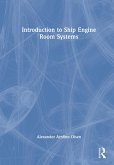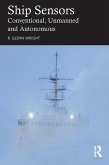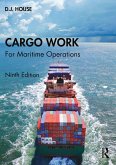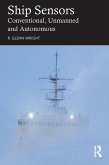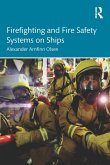Alexander Arnfinn Olsen
Introduction to Ship Engine Room Systems (eBook, PDF)
68,95 €
68,95 €
inkl. MwSt.
Sofort per Download lieferbar

34 °P sammeln
68,95 €
Als Download kaufen

68,95 €
inkl. MwSt.
Sofort per Download lieferbar

34 °P sammeln
Jetzt verschenken
Alle Infos zum eBook verschenken
68,95 €
inkl. MwSt.
Sofort per Download lieferbar
Alle Infos zum eBook verschenken

34 °P sammeln
Alexander Arnfinn Olsen
Introduction to Ship Engine Room Systems (eBook, PDF)
- Format: PDF
- Merkliste
- Auf die Merkliste
- Bewerten Bewerten
- Teilen
- Produkt teilen
- Produkterinnerung
- Produkterinnerung

Bitte loggen Sie sich zunächst in Ihr Kundenkonto ein oder registrieren Sie sich bei
bücher.de, um das eBook-Abo tolino select nutzen zu können.
Hier können Sie sich einloggen
Hier können Sie sich einloggen
Sie sind bereits eingeloggt. Klicken Sie auf 2. tolino select Abo, um fortzufahren.

Bitte loggen Sie sich zunächst in Ihr Kundenkonto ein oder registrieren Sie sich bei bücher.de, um das eBook-Abo tolino select nutzen zu können.
This outlines the key systems, machinery and equipment found in a ship's engine room, from their function to operation and maintenance. It is an introduction for marine engineering HNC, HND and foundation degree students and cadets, and a useful guide for deck officers and cadets.
- Geräte: PC
- mit Kopierschutz
- eBook Hilfe
Andere Kunden interessierten sich auch für
![Introduction to Ship Engine Room Systems (eBook, ePUB) Introduction to Ship Engine Room Systems (eBook, ePUB)]() Alexander Arnfinn OlsenIntroduction to Ship Engine Room Systems (eBook, ePUB)68,95 €
Alexander Arnfinn OlsenIntroduction to Ship Engine Room Systems (eBook, ePUB)68,95 €![Ship Sensors (eBook, PDF) Ship Sensors (eBook, PDF)]() R. Glenn WrightShip Sensors (eBook, PDF)51,95 €
R. Glenn WrightShip Sensors (eBook, PDF)51,95 €![Cargo Work (eBook, PDF) Cargo Work (eBook, PDF)]() D. J. HouseCargo Work (eBook, PDF)85,95 €
D. J. HouseCargo Work (eBook, PDF)85,95 €![Ship Sensors (eBook, ePUB) Ship Sensors (eBook, ePUB)]() R. Glenn WrightShip Sensors (eBook, ePUB)51,95 €
R. Glenn WrightShip Sensors (eBook, ePUB)51,95 €![Firefighting and Fire Safety Systems on Ships (eBook, PDF) Firefighting and Fire Safety Systems on Ships (eBook, PDF)]() Alexander Arnfinn OlsenFirefighting and Fire Safety Systems on Ships (eBook, PDF)49,95 €
Alexander Arnfinn OlsenFirefighting and Fire Safety Systems on Ships (eBook, PDF)49,95 €![Maritime Cargo Operations (eBook, PDF) Maritime Cargo Operations (eBook, PDF)]() Alexander Arnfinn OlsenMaritime Cargo Operations (eBook, PDF)49,95 €
Alexander Arnfinn OlsenMaritime Cargo Operations (eBook, PDF)49,95 €![Recreating the Power Grid (eBook, PDF) Recreating the Power Grid (eBook, PDF)]() Jagoron MukherjeeRecreating the Power Grid (eBook, PDF)34,95 €
Jagoron MukherjeeRecreating the Power Grid (eBook, PDF)34,95 €-
-
-
This outlines the key systems, machinery and equipment found in a ship's engine room, from their function to operation and maintenance. It is an introduction for marine engineering HNC, HND and foundation degree students and cadets, and a useful guide for deck officers and cadets.
Dieser Download kann aus rechtlichen Gründen nur mit Rechnungsadresse in A, B, BG, CY, CZ, D, DK, EW, E, FIN, F, GR, HR, H, IRL, I, LT, L, LR, M, NL, PL, P, R, S, SLO, SK ausgeliefert werden.
Produktdetails
- Produktdetails
- Verlag: Taylor & Francis eBooks
- Seitenzahl: 424
- Erscheinungstermin: 6. April 2023
- Englisch
- ISBN-13: 9781000836561
- Artikelnr.: 67473727
- Verlag: Taylor & Francis eBooks
- Seitenzahl: 424
- Erscheinungstermin: 6. April 2023
- Englisch
- ISBN-13: 9781000836561
- Artikelnr.: 67473727
- Herstellerkennzeichnung Die Herstellerinformationen sind derzeit nicht verfügbar.
Alexander Olsen is a Senior Consultant at RINA Consulting Defence UK. He is STCW II 1995 qualified and has also worked as a marine training designer, marine auditor, and fisheries observer. He is the author of Introduction to Ship Operations and Onboard Safety and Core Concepts of Maritime Navigation (both with Routledge, 2022).
Part I. Steering and Propulsion Systems. 1. Rudder and Steering Gear. 2.
Propeller Design and Function. 3. Introduction to the Main Engine. 4. Key
Components of the Main Engine. 5. Main Engine Pre-Start Checks and
Monitoring. 6. Slow Steaming and Economic Fuel Consumption. 7. Exhaust Gas
System and Scrubbers. 8. Engine Room Lubrication Systems. 9. Essential
Engine Room Machinery Maintenance and Troubleshooting. 10. Mechanical
Measuring Tools and Gauges. Part II. Power Generation. 11. Marine Diesel
Generators. 12. Marine Electrical Systems. 13. Electrical Distribution
Systems and Redundancy. 14. Air Compressor. Part III. Heating, Ventilation
and Air Conditioning. 15. Marine Boiler. 16. Central Cooling System. 17.
Refrigeration and Air Conditioning. Part IV. Water Management Systems. 18.
Ballast Water Management. 19. Oily Water Separator. 20. Wastewater
Management. 21. Freshwater Generation. 22. Pipes, Tubes, Bends and Valves.
Part V. Engine Room Tanks and Bunkering Operations. 23. Main Fuel, Diesel
and Lube Oil Tanks on Ships. 24. Bunkering Operations. Part VI. Engine Room
Fires and Emergency Response. 25. General Emergency Drills, Alarms and
Emergency Systems. 26. Engine Room Explosions and Fires. 27. Engine Room
Drills, Firefighting Procedures and Apparatus. 28. Engine Room Flooding.
Part VII. Engine Room Watch Procedures. 29. Engine Room Watch Procedures.
30. Engine Room Logbook Entries and Checklists. Appendix. Recommended
Reading for Marine Engineers.
Propeller Design and Function. 3. Introduction to the Main Engine. 4. Key
Components of the Main Engine. 5. Main Engine Pre-Start Checks and
Monitoring. 6. Slow Steaming and Economic Fuel Consumption. 7. Exhaust Gas
System and Scrubbers. 8. Engine Room Lubrication Systems. 9. Essential
Engine Room Machinery Maintenance and Troubleshooting. 10. Mechanical
Measuring Tools and Gauges. Part II. Power Generation. 11. Marine Diesel
Generators. 12. Marine Electrical Systems. 13. Electrical Distribution
Systems and Redundancy. 14. Air Compressor. Part III. Heating, Ventilation
and Air Conditioning. 15. Marine Boiler. 16. Central Cooling System. 17.
Refrigeration and Air Conditioning. Part IV. Water Management Systems. 18.
Ballast Water Management. 19. Oily Water Separator. 20. Wastewater
Management. 21. Freshwater Generation. 22. Pipes, Tubes, Bends and Valves.
Part V. Engine Room Tanks and Bunkering Operations. 23. Main Fuel, Diesel
and Lube Oil Tanks on Ships. 24. Bunkering Operations. Part VI. Engine Room
Fires and Emergency Response. 25. General Emergency Drills, Alarms and
Emergency Systems. 26. Engine Room Explosions and Fires. 27. Engine Room
Drills, Firefighting Procedures and Apparatus. 28. Engine Room Flooding.
Part VII. Engine Room Watch Procedures. 29. Engine Room Watch Procedures.
30. Engine Room Logbook Entries and Checklists. Appendix. Recommended
Reading for Marine Engineers.
Part I. Steering and Propulsion Systems. 1. Rudder and Steering Gear. 2.
Propeller Design and Function. 3. Introduction to the Main Engine. 4. Key
Components of the Main Engine. 5. Main Engine Pre-Start Checks and
Monitoring. 6. Slow Steaming and Economic Fuel Consumption. 7. Exhaust Gas
System and Scrubbers. 8. Engine Room Lubrication Systems. 9. Essential
Engine Room Machinery Maintenance and Troubleshooting. 10. Mechanical
Measuring Tools and Gauges. Part II. Power Generation. 11. Marine Diesel
Generators. 12. Marine Electrical Systems. 13. Electrical Distribution
Systems and Redundancy. 14. Air Compressor. Part III. Heating, Ventilation
and Air Conditioning. 15. Marine Boiler. 16. Central Cooling System. 17.
Refrigeration and Air Conditioning. Part IV. Water Management Systems. 18.
Ballast Water Management. 19. Oily Water Separator. 20. Wastewater
Management. 21. Freshwater Generation. 22. Pipes, Tubes, Bends and Valves.
Part V. Engine Room Tanks and Bunkering Operations. 23. Main Fuel, Diesel
and Lube Oil Tanks on Ships. 24. Bunkering Operations. Part VI. Engine Room
Fires and Emergency Response. 25. General Emergency Drills, Alarms and
Emergency Systems. 26. Engine Room Explosions and Fires. 27. Engine Room
Drills, Firefighting Procedures and Apparatus. 28. Engine Room Flooding.
Part VII. Engine Room Watch Procedures. 29. Engine Room Watch Procedures.
30. Engine Room Logbook Entries and Checklists. Appendix. Recommended
Reading for Marine Engineers.
Propeller Design and Function. 3. Introduction to the Main Engine. 4. Key
Components of the Main Engine. 5. Main Engine Pre-Start Checks and
Monitoring. 6. Slow Steaming and Economic Fuel Consumption. 7. Exhaust Gas
System and Scrubbers. 8. Engine Room Lubrication Systems. 9. Essential
Engine Room Machinery Maintenance and Troubleshooting. 10. Mechanical
Measuring Tools and Gauges. Part II. Power Generation. 11. Marine Diesel
Generators. 12. Marine Electrical Systems. 13. Electrical Distribution
Systems and Redundancy. 14. Air Compressor. Part III. Heating, Ventilation
and Air Conditioning. 15. Marine Boiler. 16. Central Cooling System. 17.
Refrigeration and Air Conditioning. Part IV. Water Management Systems. 18.
Ballast Water Management. 19. Oily Water Separator. 20. Wastewater
Management. 21. Freshwater Generation. 22. Pipes, Tubes, Bends and Valves.
Part V. Engine Room Tanks and Bunkering Operations. 23. Main Fuel, Diesel
and Lube Oil Tanks on Ships. 24. Bunkering Operations. Part VI. Engine Room
Fires and Emergency Response. 25. General Emergency Drills, Alarms and
Emergency Systems. 26. Engine Room Explosions and Fires. 27. Engine Room
Drills, Firefighting Procedures and Apparatus. 28. Engine Room Flooding.
Part VII. Engine Room Watch Procedures. 29. Engine Room Watch Procedures.
30. Engine Room Logbook Entries and Checklists. Appendix. Recommended
Reading for Marine Engineers.

